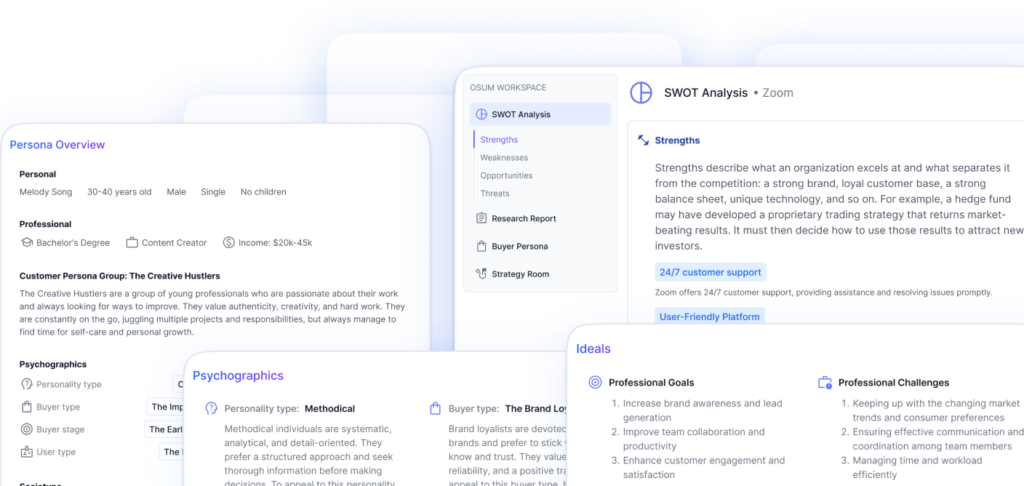Importance of Consumer Profiling
In the world of marketing, understanding your customers is crucial for success. This is where consumer profiling plays a vital role. By delving into the needs, preferences, and behaviors of your target audience, you can develop effective strategies to tailor your marketing efforts and drive better results.
Understanding Customer Needs
Consumer profiling involves gathering and analyzing data on your customers’ demographics, psychographics, and buying patterns. This information provides valuable insights into who your customers are and what they want. According to HubSpot Blogs, customer profiling helps you identify segments of customers with commonalities, allowing you to target them effectively in your sales and marketing campaigns.
Creating accurate and detailed customer profiles helps you understand the pain points and motivations of your customers. It enables you to gain a deeper understanding of their desires and challenges, allowing you to develop products and services that truly meet their needs.
Targeted Marketing Strategies
One of the key benefits of consumer profiling is the ability to develop targeted marketing strategies. With a clear understanding of your customers’ characteristics and preferences, you can tailor your messaging, content, and offers to resonate with their specific interests.
By leveraging consumer profiling, you can create personalized marketing campaigns that speak directly to your target audience. This approach goes beyond basic demographics and enables you to craft messages that address the unique behaviors, perceptions, attitudes, and interests of your customers.
Personalized marketing has become increasingly important in today’s consumer landscape. As stated by GlobalWebIndex, consumers expect brands to deliver a personalized experience at every touchpoint. By utilizing consumer profiling, you can meet these expectations and provide tailored content that resonates with individual consumers.
Targeted marketing strategies not only improve customer engagement but also increase the effectiveness of your marketing efforts. By focusing your resources on the right audience, you can maximize your return on investment and achieve better results.
In conclusion, consumer profiling is an essential tool for understanding your customers and developing effective marketing strategies. By gaining insights into customer needs and preferences, you can create personalized experiences, enhance customer engagement, and drive better business outcomes. Make the most of consumer profiling by utilizing the right consumer profiling strategies and consumer profiling tools to gain a competitive edge in the market.
Benefits of Consumer Profiling
Consumer profiling plays a vital role in helping businesses understand their customers better and develop effective marketing strategies. By gaining insights into customer needs, preferences, and behaviors, businesses can tailor their efforts to meet the expectations of their target audience. Here are three key benefits of consumer profiling:
Improved Customer Retention
One of the significant benefits of consumer profiling is the ability to enhance customer retention rates. Studies have shown that increasing customer retention by just 5% can result in a 25% to 95% boost in profits (Faster Capital). By understanding customer needs and preferences through comprehensive market research and customer profiles, businesses can make informed decisions about product development, pricing, branding, and marketing strategies. This customer-centric approach helps build strong relationships, fosters brand loyalty, and increases the customer lifetime value (mFasis on LinkedIn).
Cost-Effectiveness in Marketing
Acquiring new customers can be significantly more expensive than retaining existing ones. In fact, it can cost up to five times more to acquire a new customer (Faster Capital). By leveraging consumer profiling, businesses can allocate their marketing budget, time, and efforts more effectively. By understanding who their customers are and what they value, companies can optimize their marketing strategies and campaigns, ensuring that resources are focused on high-potential segments. This efficient resource allocation leads to cost-effective marketing efforts and better returns on investment.
Enhanced Customer Engagement
Customer profiles enable businesses to engage with their customers in a more personalized and meaningful way. By understanding customers’ psychographic characteristics, businesses can create highly targeted marketing campaigns and tailor their communication to individual preferences. This level of personalization enhances customer engagement and fosters strong relationships. Through personalized email newsletters, social media engagement, and tailored content, businesses can effectively communicate with their customers, building brand loyalty and increasing customer satisfaction (mFasis on LinkedIn).
By leveraging the benefits of consumer profiling, businesses can improve customer retention, optimize marketing efforts, and enhance customer engagement. By understanding their customers’ needs, preferences, and behaviors, businesses can develop targeted marketing strategies, allocate resources efficiently, and foster strong relationships with their target audience. The result is a more effective and successful marketing approach that drives customer satisfaction and business growth.
Components of Customer Profiles
To effectively target and engage customers, it is essential to construct detailed customer profiles that encompass various aspects of their preferences, habits, and needs. Customer profiles typically consist of three key components: demographics, psychographic data, and buying patterns.
Demographics
Demographic information forms the foundation of customer profiles. It includes objective data such as age, gender, income, education, occupation, and geographic location. These demographic factors provide valuable insights into the characteristics of your target audience and help identify commonalities among your customers.
By analyzing demographic data, businesses can gain a better understanding of who their customers are and align their marketing strategies accordingly. For instance, if your product or service is more relevant to a specific age group or income bracket, demographic profiling can help tailor your messaging and distribution channels to reach the right audience.
Psychographic Data
Psychographic information delves into the attitudes, values, interests, and lifestyles of customers. It goes beyond demographics to provide a deeper understanding of their motivations, preferences, and behaviors. Psychographic profiling enables businesses to create a more intricate, individualized picture of potential customers, reflecting specific preferences and behaviors.
Psychographic data may include information about customers’ hobbies, interests, opinions, beliefs, social activities, and cultural influences. This information helps businesses segment their target audience more effectively and personalize their marketing efforts. By understanding the psychographic makeup of their customers, businesses can tailor their messaging, product offerings, and experiences to resonate on a more personal level.
Buying Patterns
Analyzing the buying patterns of customers is crucial for effective consumer profiling. This component focuses on understanding customers’ purchasing behavior, including the frequency of purchases, average transaction value, preferred channels, and product/service preferences.
By examining buying patterns, businesses can identify trends, preferences, and potential opportunities to optimize their marketing strategies. For example, if customers tend to make repeat purchases or show a preference for specific product features, businesses can create loyalty programs or develop targeted promotions to encourage customer retention and increase sales.
Understanding the components of customer profiles provides businesses with a comprehensive understanding of their target audience. By leveraging demographic information, psychographic data, and buying patterns, businesses can tailor their strategies and offerings effectively to meet customer needs and preferences.
For more insights into the benefits and techniques of consumer profiling, check out our articles on consumer profiling strategies, consumer profiling tools, and consumer profiling examples.
Utilizing Customer Profiles
Once customer profiles have been created through effective consumer profiling, businesses can leverage these profiles in various ways to enhance their marketing strategies and maximize their success. Here are three key ways to utilize customer profiles:
Personalized Product Development
By analyzing customer profiles, businesses gain valuable insights into the needs, preferences, and pain points of their target audience. This knowledge enables companies to develop products or services that precisely align with customer requirements, ultimately fostering customer loyalty and a strong reputation. Understanding customer preferences allows for tailored offerings that stand out in the market (mFasis on LinkedIn). Personalized product development based on customer profiles helps businesses stay ahead of the competition and build a loyal customer base.
Targeted Marketing Campaigns
Customer profiles play a crucial role in designing highly targeted marketing campaigns. By leveraging the demographic, psychographic, and behavioral data captured in the profiles, businesses can craft compelling messages and select appropriate marketing channels to reach their target audience effectively. This targeted approach increases the likelihood of conversion, improves return on investment, and minimizes wasteful spending on broad and ineffective marketing efforts. Customer profiling enables businesses to create personalized marketing campaigns that resonate with individual consumers, resulting in higher engagement and conversion rates (GlobalWebIndex).
Efficient Resource Allocation
Efficient resource allocation is another significant benefit of customer profiling. By understanding the characteristics and preferences of their target audience, businesses can identify valuable customer segments. This knowledge allows for the optimization of marketing budgets, streamlining of operations, and enhancement of the overall customer experience. By focusing efforts on high-potential segments, businesses can allocate their resources more effectively, ensuring that marketing campaigns, customer support, and product development efforts are directed toward the most valuable customers. Efficient resource allocation based on customer profiles helps businesses achieve better performance and maximize their return on investment (mFasis on LinkedIn).
By utilizing customer profiles for personalized product development, targeted marketing campaigns, and efficient resource allocation, businesses can enhance their marketing strategies and achieve greater success. Customer profiling enables businesses to understand their customers on a deeper level, enabling them to create products and services that cater to their needs, design marketing campaigns that resonate with their target audience, and allocate resources wisely for optimal results.

